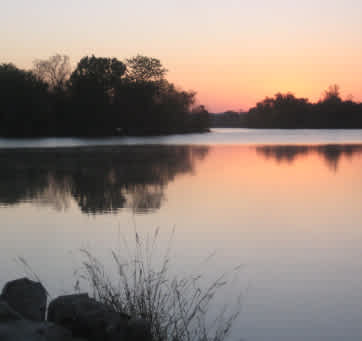Finding Whitetail Rubs in October
In Search of Whitetails 10.18.12

This morning I set out to check on my tree stand on public land, and to set up my new game camera nearby. When I went out to put up the stand a couple of weeks ago, the weather was warm, the mosquitoes miserable, and the leaves dry and crunchy. Worse, the woods were almost completely devoid of deer sign.
My goal was to inspect a couple of potential pinch points that I’d identified using topographic maps and Google Earth. One is a narrow strip of woods between open farmland and the river; the other is formed by an inlet from the river on one side, and what I thought was an open field on the other. It turns out that the field was actually marsh, covered with a couple of inches of water. And the inlet was uncrossable. This formed a sort of natural corner where I set up my stand along a game trail.
Today the woods were much more favorable for hunting. The wind was slow but steady out of the west/northwest. A couple of days of rain had muffled the dry leaves, allowing me to move in near silence. And, thanks to cooler temperatures, the mosquitoes kept away.

The First Whitetail Rubs of the Season
Perhaps most importantly, I found some very recent rubs in the woods not far from my stand. The first of these was highly visible: south-facing, waist high, and about the size of a shoe box. It was so large that I thought it might be the work of a beaver–I’ve seen some of their handiwork along the river–but close inspection ruled that out. It was too high for a beaver to reach, and the marks weren’t made by teeth. I was a bit surprised at the thickness of the tree (about 6-7″ in diameter; you can see my carbon arrow in the foreground for some perspective).
The best evidence that this was a whitetail rub was the presence of another rub about 10 yards away. This one was on a more typical wrist-thick sapling, though the tree was at a horizontal angle, and the rub almost chest-high. It must have been the perfect height, because the buck rubbed off a good three feet of bark:
I was sorely tempted to set up my game camera right between these two rubs. But since I was planning to spend some time on the stand, I marked the spot in my GPS and went on.

Setting Up My Game Camera
My game camera is an 8-megabyte trail camera with night vision. It has three default settings (single-shot, triple-shot, and 30 second video). Obviously I opted for the video setting, on the off chance that I saw some game while I was still on the stand. What makes for the best game camera location? I have no idea, but rub lines and the intersection of game trails seem promising. I like the idea of having the camera close to my stand — I can pull out the memory card and see if anything has come by since I set it up.
Too Early for Scrapes?
Scrape hunting is a proven technique for the pre-rut, according to what I read. Unfortunately I haven’t been able to find a single legitimate scrape on any of my hunting expeditions. Either I’m missing them or they just haven’t been made yet. The appearance of fresh rubs, however, indicates that I might come across scrapes in the weeks to come.
The post Finding Whitetail Rubs in October appeared first on In Search of Whitetails and is republished with permission.

